
When And How To Germinate Hot Pepper Seeds
It's no secret that cultivating hot peppers is a hugely rewarding task that not only hones your skills as a grower, but also provides you with a great yield of spicy chillies each time. But where do you start? Or, perhaps more importantly, when and how? It all begins with germination. Read our guide for everything you need to know.
Regardless of the type of hot pepper plant you choose to grow, the fact remains that they need a little help when they first start out. By all means, you can leave it to chance and just plant your seeds in soil and wait for them to do their thing. However, to really kick-start your grow, they've got to be germinated properly.
But when and how do you go about it? Well, we're so glad you asked, as we'll take you through everything you need to know to ensure your hot pepper plants get the best start possible. In the end, proper germination will allow your plants to flourish and provide some great-tasting, super-hot peppers come harvest. Sound good? Let's begin.
What do hot pepper seeds need to germinate?
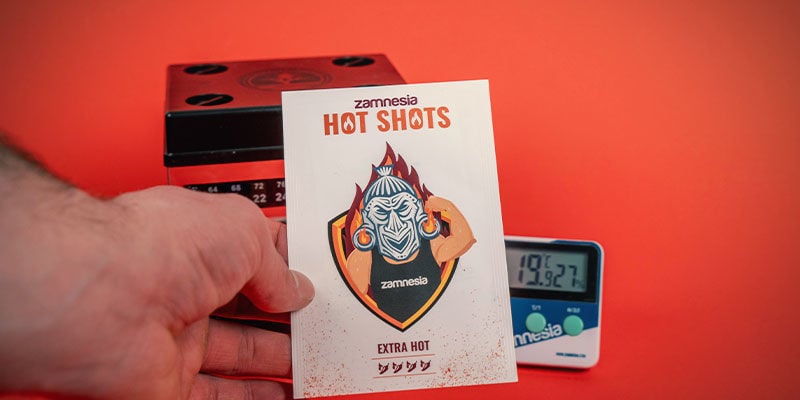
For the most part, pepper seeds aren't fussy. That's not to say they're without any complications, but most of these can be avoided by providing your seeds with the right environment. Pepper seeds require the following to germinate: warm temperatures, high humidity, and darkness.
Temperature
It's likely no surprise that pepper seeds need consistently warm temperatures to germinate. While exact temperature suggestions vary among different hot pepper plants, as a rule of thumb, pepper seeds like to be quite warm, ideally at temperatures of around 26–32°C (80–90°F).
However, those living in colder climates needn't worry, as there are plenty of options for pepper growers in less than ideal environments. Many turn to placing their seeds in an airing cupboard or on a seedling heat mat to provide consistent warmth. We'll touch upon this a little more later on.
Humidity
Hand in hand with temperature comes humidity. Pepper seeds need to attain a certain level of moisture to sprout. Seeds that are too dry will not grow any further. It's a fine balancing act to keep the growing area humid but warm. However, it's entirely possible to use seed starter trays that come complete with a humidity dome to place over the top.
Combined with a consistent temperature, the inside of the tray will easily reach and maintain a 100% humidity level. It's in this environment that pepper seeds really reach their potential.
Darkness
The last factor to consider when germinating pepper seeds is how much (or rather, how little) light to provide. The answer is—none. That's right, whereas hot pepper plants need a routine schedule of sunlight or artificial light to flourish, the seeds actually require the opposite. So as soon as you've set the right temperature and relative humidity, leave your seeds with the lights off and let them germinate.
When to start germinating pepper seeds?
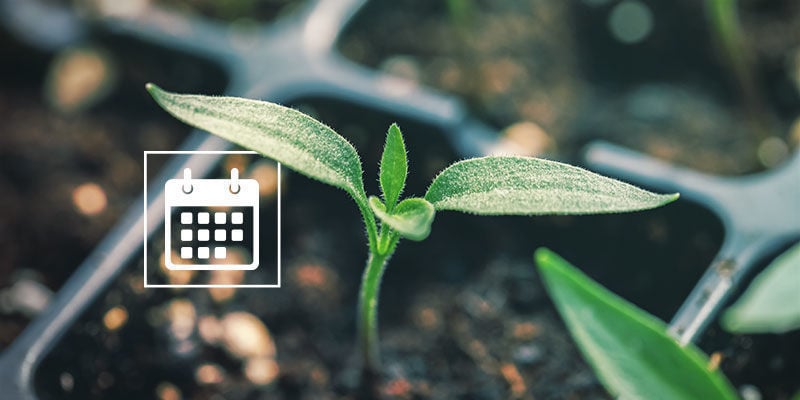
When it comes to starting the pepper seed germination process, ideally, you'll want to begin early in the year—as early as February or March in the Northern Hemisphere. This is to maximise your plants’ exposure to the natural warmth and strong sunlight to come in the following months. So it's ideal to germinate your seeds and prepare your seedlings for spring and summer conditions.
Of course, if you're growing hot peppers indoors, it won't really matter what month you choose to germinate, as long as you sufficiently replicate the ideal environment.
How long do pepper seeds take to germinate?
How long it takes for pepper seeds to germinate really depends on the variety you’ve chosen. Regardless of how ideal the conditions are, seeds will still take their own time to germinate. Some pepper seeds take around 10 days to sprout, whereas others need between 3 and 4 weeks to show any signs of progress.
However, the information on your chosen pepper seed packet should advise you so it's not so much of a guessing game. But overall, just have a little patience when germinating.
How to germinate pepper seeds
Now that we’ve covered all of the surrounding factors, how do you actually go about germinating seeds?
There are a few different schools of thought, and below we’ll review the three most common. By all means, these aren't the only ways to germinate pepper seeds, as growers have found some pretty unique and inventive ways to start their plants off. The key is to find a solution that works for you.
Germinating pepper seeds using the paper towel method
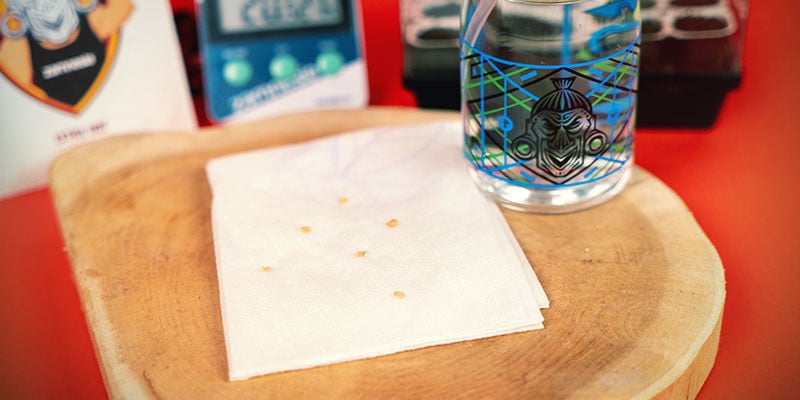
For those looking to begin their pepper seeds indoors, paper towels provide a suitable germination vessel.
Begin by wetting a few sheets of paper towel with a spray bottle, or lightly soak them under a tap. You want them wet enough to wring out. Wringing them out will remove excess water but will keep them moist, and that's key here; we want the towels to be damp but not soaked through.
Next, fold your paper towel in half and place in your seeds. Ideally, you'll want to keep about an inch of space between each seed. This will give them the room they need to germinate without any complication. Once in position, fold the towel over once more to cover the seeds.
Now you'll need somewhere to place them; this can be in a sandwich bag or plastic container. Note that you don't want to seal the environment completely. Allow about an inch opening for a little bit of airflow.
As mentioned, it's now a case of keeping your container or bag in a secure, warm, and dark spot. Once placed in a suitable environment, check on your pepper seeds once a day. While they like to remain warm, they don't want to dry out, so give them a little spray of water now and again if you think they need it. In no time, you’ll see your first seeds sprouting.
Germinating pepper seeds in water
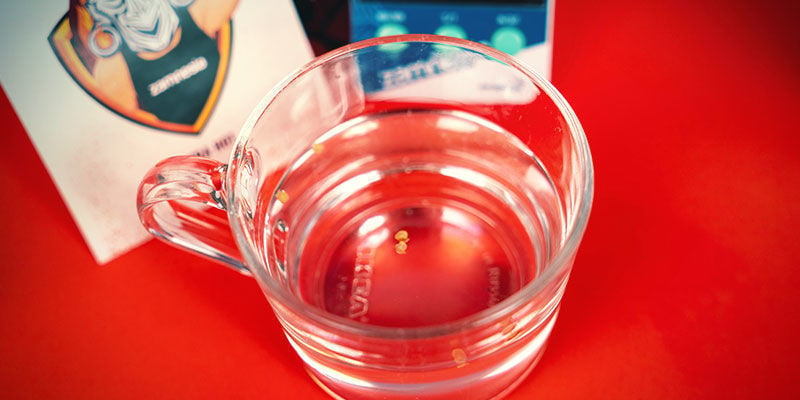
This popular method of germinating cannabis seeds works for hot peppers as well! That's right, you can germinate pepper seeds in water, as it provides a constant level of moisture. But this is only designed to be done for short amounts of time. While other germination methods wait for the seed to sprout, germinating in water only allows the seed to crack before it’s placed in the soil.
Start by filling a glass with tap water, and let it sit for a few hours so it reaches room temperature. Once at the desired temperature, drop a few seeds into the glass and let them sit. Keep an eye on the glass each day while maintaining the temperature of the water, and add more water if needed. After a period of 4–5 days, you should see the seeds begin to crack; this is the moment they should be removed from the water and placed into potting soil so they can start to sprout properly.
Germinating pepper seeds in soil
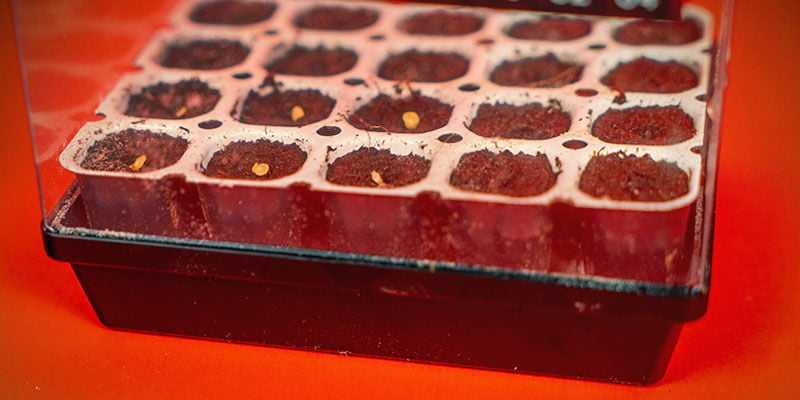
Arguably the most popular method of germinating pepper seeds is simply placing them in soil. This can be in a selection of small containers you already own, or you can buy a specific seed tray starter set designed for the germination stage. By picking up a ready-made seed tray, the hard work is essentially already done, as many come complete with the perfect potting soil for seeds to flourish in.
If you're using your own containers, begin by filling them with moist potting soil. If you’re using a seed tray, either add some soil if there's none provided or simply spray the included substrate. Now that your soil is ready to house the seed, use a pen or pencil to poke a small hole roughly a quarter of an inch deep into the soil.
Place an individual seed into each hole you've created, then lightly cover with soil. Once covered, give it a quick spray to ensure the soil remains moist. Now that you've got your containers ready, place them either on a heat mat or in a warm environment, such as on top of the fridge. As mentioned, feel free to add a humidity dome to ensure the inside maintains an appropriate moisture level.
After a period of roughly 7 to 10 days, you'll begin to see progress as the seeds start to sprout. Be sure to keep an eye on them during this time and, of course, give them a spray of water now and again if they look as though they're drying up a little.
Tips for germinating hot pepper seeds

So, what else can you do to ensure that your pepper seeds succeed? For the most part, it's the environment you provide that will make or break germination. However, there are a few extra tips to consider if you really want to give your plants the best chance of thriving from the get-go.
Consider a heat mat
We've briefly touched upon the use of a heat mat throughout this article, but the importance of consistent heat for germinating chilli seeds cannot be understated. Available for a very reasonable price, heat mats are ideal for those who live in colder climates or feel as though they don't have the right germination environment.
A small heat mat can be easily tucked away and provides enough space for most containers. Giving your seeds the right heat level will make all the difference!
Soften the seed shell beforehand
Give your seeds a helping hand by softening the shell before placing them in a damp towel, soil, or water. Many choose to soak their seeds in a weak cup of chamomile tea for around 24–48 hours. Not only does this make it easier for the roots to break free, but it can kill off any bacteria that may potentially cause harm.
Keep an eye on water pH
Be sure to test the pH level of your water before you spray your soil. If the level is too high or too low (below 5.5 or above 7), the seeds are less likely to sprout. If the water isn't at the correct level, you can use distilled water, rainwater, or even tap water that's been sitting out for around 24 hours.
Give them some fresh air
While the aim is to provide germinating pepper seeds with a warm, humid atmosphere, a little bit of oxygen actually goes a long way. If you're using a humidity dome, there should be vents at the top that can open to give your seeds a little air. Refresh the air by opening these once a day while checking on your chilli seeds.
When to transplant hot pepper seedlings?
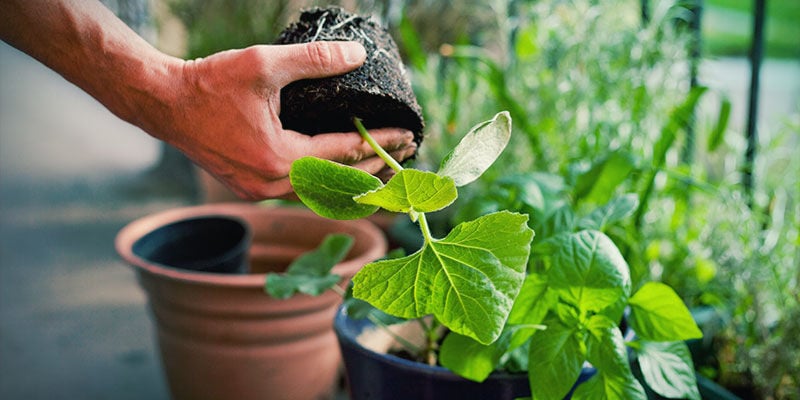
If you've kept up a good maintenance routine, it shouldn't take long for your seeds to sprout. Now, it's almost time for the crucial step of transplanting them into bigger soil-filled containers. But when is the best time to do so?
The process is straightforward if you've germinated your chilli seeds in seed trays. As a rule of thumb, it's best to wait until the seedling has sprouted its third set of true leaves. This is usually around 4–6 weeks post-germination. It is at this point that they can be removed and transplanted to new containers or an outdoor patch.
Timing is crucial, so, again, try and coincide your transplanting with the start of warmer months to make the most of the light and heat. But above all, be patient and ensure that your pepper plants are well looked-after, and they will undoubtedly reward you with a bounty of scorching hot peppers to enjoy.
-
 8 min
18 March 2022
How To Grow Hot Peppers Outdoors
There's nothing quite like having your own supply of spicy hot peppers. And while it may seem a daunting task to grow them outdoors, we're here to show that it's really not! All you need to do is...
8 min
18 March 2022
How To Grow Hot Peppers Outdoors
There's nothing quite like having your own supply of spicy hot peppers. And while it may seem a daunting task to grow them outdoors, we're here to show that it's really not! All you need to do is...
-
 5 min
7 March 2022
How To Fertilise Hot Pepper Plants
There is a fine art to providing your plants with all the nutrients they need. Here's a breakdown of why and how to use fertiliser to maximise the potential of your pepper plants. Trust us; your...
5 min
7 March 2022
How To Fertilise Hot Pepper Plants
There is a fine art to providing your plants with all the nutrients they need. Here's a breakdown of why and how to use fertiliser to maximise the potential of your pepper plants. Trust us; your...
-
 7 min
4 March 2022
How To Grow Hot Peppers Indoors
Growing chillies might seem like a complicated task, but we're here to tell you that it really needn't be. Even if you don't have an adequate space outside to grow them, you can produce some...
7 min
4 March 2022
How To Grow Hot Peppers Indoors
Growing chillies might seem like a complicated task, but we're here to tell you that it really needn't be. Even if you don't have an adequate space outside to grow them, you can produce some...
-
 4 min
18 February 2022
Tips For Growing Hotter Chilli Pepper Plants
Surely it's down to chance just how hot your chilli peppers can be, right? Well, while various factors determine spice level, there are actually several things you can do to really get the hottest...
4 min
18 February 2022
Tips For Growing Hotter Chilli Pepper Plants
Surely it's down to chance just how hot your chilli peppers can be, right? Well, while various factors determine spice level, there are actually several things you can do to really get the hottest...
-
 5 min
24 January 2022
When And How To Harvest Hot Peppers
You've taken the time to cultivate hot peppers, giving them everything they need to flourish throughout their growing cycle. Yet, arguably the most critical moment is fast approaching; when and how...
5 min
24 January 2022
When And How To Harvest Hot Peppers
You've taken the time to cultivate hot peppers, giving them everything they need to flourish throughout their growing cycle. Yet, arguably the most critical moment is fast approaching; when and how...
-
 7 min
12 August 2021
Growing Peppers For Beginners In 10 Easy Steps
Growing peppers at home can be a hugely rewarding task. Harvesting your own carefully cultivated chillies to use in cooking is a great feeling. But, from seed to harvest, how do you achieve this?...
7 min
12 August 2021
Growing Peppers For Beginners In 10 Easy Steps
Growing peppers at home can be a hugely rewarding task. Harvesting your own carefully cultivated chillies to use in cooking is a great feeling. But, from seed to harvest, how do you achieve this?...













 United States
United States










